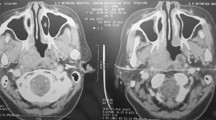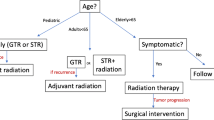Abstract
Introduction
This study aims to investigate the spectrum of magnetic resonance imaging (MRI) features following endoscopic potassium-titanyl-phosphate (KTP) laser nasopharyngectomy.
Methods
From January 2005 to December 2010, a total of 35 patients underwent KTP laser nasopharyngectomy for early recurrent NPC (rT1 or rT2) at our institute. Those who were lost to follow-up (N = 2) were excluded. Among the remaining patients, ten were proved to have locally recurrent disease and the other 23 not locally recurrent within 2 years of postoperative follow-up. Their serial MRIs were evaluated.
Results
Postoperative nasopharyngeal mucosal changes were present in all of the subjects on first follow-up MRI, ranged from focal mucosal thinning (19/33, 57.6 %), focal mucosal thickening (8/33, 24.2 %) to mixed thinning and thickening (6/33, 18.2 %). Nasopharyngeal submucosal soft tissue volume loss was found in 23 (23/33, 69.7 %), and parapharyngeal soft tissue necrosis was found in 3 (3/33, 9.1 %). Postoperative bone marrow change involved the clivus in 31 (31/33, 93.9 %) and the petrous or pterygoid in 17 (17/33, 51.5 %). There were no significant differences between the two groups in the changes of mucosa, adjacent soft tissue, and skull base on the first MRI. The evaluation of serial MRIs disclosed that the patients in the recurrent group were more likely to develop new or enlarging mucosal masses (p = 0.01) and enlarging skull base changes (p = 0.0001).
Conclusions
KTP laser nasopharyngectomy induces mucosal and skull base changes that could be misinterpreted as tumor progression on early postoperative MRI scans. Sequential imaging is required to distinguish between postoperative changes and progressive disease.



Similar content being viewed by others
References
Chong VF, Ong CK (2008) Nasopharyngeal carcinoma. Eur J Radiol 66(3):437–447. doi:10.1016/j.ejrad.2008.03.029
Ko JY, Wang CP, Ting LL, Yang TL, Tan CT (2009) Endoscopic nasopharyngectomy with potassium-titanyl-phosphate (KTP) laser for early locally recurrent nasopharyngeal carcinoma. Head neck 31(10):1309–1315. doi:10.1002/hed.21091
Li H, Wang DL, Liu XW, Chen MY, Mo YX, Geng ZJ, Xie CM (2013) MRI signal changes in the skull base bone after endoscopic nasopharyngectomy for recurrent NPC: a serial study of 9 patients. Eur J Radiol 82(2):309–315. doi:10.1016/j.ejrad.2012.10.022
Suarez C, Rodrigo JP, Rinaldo A, Langendijk JA, Shaha AR, Ferlito A (2010) Current treatment options for recurrent nasopharyngeal cancer. Eur Arch Otorhinolaryngol 267(12):1811–1824. doi:10.1007/s00405-010-1385-x
Ng SH, Liu HM, Ko SF, Hao SP, Chong VF (2002) Posttreatment imaging of the nasopharynx. Eur J Radiol 44(2):82–95
Tan CT, Hsiao SH, Hwang JH, Ko JY, Hsu MM (2005) Potassium-titanyl-phosphate laser nasopharyngectomy with nasopharyngoscopic guidance for recurrent nasopharyngeal carcinoma. J Formos Med Assoc=Taiwan yi zhi 104(12):960–963
King WW, Ku PK, Mok CO, Teo PM (2000) Nasopharyngectomy in the treatment of recurrent nasopharyngeal carcinoma: a twelve-year experience. Head neck 22(3):215–222
To EW, Yuen EH, Tsang WM, Lai EC, Wong GK, Sun DT, Chan DT, Lam JM, Ahuja A, Poon WS (2002) The use of stereotactic navigation guidance in minimally invasive transnasal nasopharyngectomy: a comparison with the conventional open transfacial approach. Brit J Radiol 75(892):345–350
Chen MK, Lai JC, Chang CC, Liu MT (2007) Minimally invasive endoscopic nasopharyngectomy in the treatment of recurrent T1-2a nasopharyngeal carcinoma. Laryngoscope 117(5):894–896. doi:10.1097/MLG.0b013e3180381644
Hao SP, Tsang NM, Chang KP, Hsu YS, Chen CK, Fang KH (2008) Nasopharyngectomy for recurrent nasopharyngeal carcinoma: a review of 53 patients and prognostic factors. Acta Otolaryngol 128(4):473–481. doi:10.1080/00016480701813806
Ozer E, Waltonen J (2008) Transoral robotic nasopharyngectomy: a novel approach for nasopharyngeal lesions. Laryngoscope 118(9):1613–1616. doi:10.1097/MLG.0b013e3181792490
Liao XB, Mao YP, Liu LZ, Tang LL, Sun Y, Wang Y, Lin AH, Cui CY, Li L, Ma J (2008) How does magnetic resonance imaging influence staging according to AJCC staging system for nasopharyngeal carcinoma compared with computed tomography? Int J Radiat Oncol Biol Phys 72(5):1368–1377. doi:10.1016/j.ijrobp.2008.03.017
Wu LA, Liu HM, Wang CW, Chen YF, Hong RL, Ko JY (2012) Osteoradionecrosis of the upper cervical spine after radiation therapy for head and neck cancer: differentiation from recurrent or metastatic disease with MR imaging. Radiology 264(1):136–145. doi:10.1148/radiol.12111714
King AD, Ahuja AT, Leung SF, Abrigo J, Wong JK, Poon WS, Woo KS, Chan HS, Tse GM (2008) MR imaging of nonmalignant polyps and masses of the nasopharynx and sphenoid sinus after radiotherapy for nasopharyngeal carcinoma. AJNR Am J Neuroradiol 29(6):1209–1214. doi:10.3174/ajnr.A1043
Becker M, Zbaren P, Casselman JW, Kohler R, Dulguerov P, Becker CD (2008) Neoplastic invasion of laryngeal cartilage: reassessment of criteria for diagnosis at MR imaging. Radiology 249(2):551–559. doi:10.1148/radiol.2492072183
Chan JY, Wei WI (2012) Recurrent nasopharyngeal carcinoma after salvage nasopharyngectomy. Arch Otolaryngol-Head Neck Surg 138(6):572–576. doi:10.1001/archoto.2012.832
Thoeny HC (2011) Diffusion-weighted MRI in head and neck radiology: applications in oncology. Cancer Imaging: Off Publ Int Cancer Imaging Soc 10:209–214. doi:10.1102/1470-7330.2010.0030
Conflict of interest
We declare that we have no conflict of interest.
Author information
Authors and Affiliations
Corresponding author
Rights and permissions
About this article
Cite this article
Chen, YF., Wang, YF., Wang, CP. et al. Magnetic resonance imaging following endoscopic nasopharyngectomy with a potassium-titanyl-phosphate (KTP) laser for early locally recurrent nasopharyngeal carcinoma. Neuroradiology 55, 1413–1421 (2013). https://doi.org/10.1007/s00234-013-1283-1
Received:
Accepted:
Published:
Issue Date:
DOI: https://doi.org/10.1007/s00234-013-1283-1




